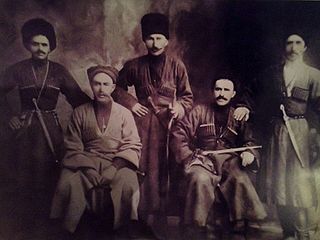Related Research Articles
Ingush, historically known as Durdzuks, Gligvi and Kists, are a Northeast Caucasian ethnic group mainly inhabiting the Republic of Ingushetia in central Caucasus, but also inhabitanting Prigorodny District and town of Vladikavkaz of modern day North-Ossetia. The Ingush are predominantly Sunni Muslims and speak the Ingush language.

The Orstkhoy, historically commonly known under their exonyms: Karabulaks, Balsu, Baloy, are a historical ethnoterritorial society among the Chechen and Ingush peoples. Their homeland is in the upper reaches of the Assa and Fortanga rivers in the historical region of Orstkhoy-Mokhk. In the tradition of the Chechen ethno-hierarchy, it is considered one of the nine historical Chechen tukkhums, in the Ingush tradition as one of the seven historical Ingush shahars.

Chakh Elmurzievich Akhriev was the first Ingush ethnographer and a lawyer by education, who recorded Ingush folklore, mythology, and culture.

The Feappii were an Ingush subgroup (society) that mostly inhabited the mountainous Fappi region of Ingushetia in the Caucasus. Historically, they bordered on the west with Dzherakh, on the east with Khamkhins, on the north with Nazranians, and in the south with Gudomakarians. The center of the society was the fortified village (aul) of Erzi or Metskhal.

Kurkhars is the traditional female headdress of the Ingush. Its male counterpart is the Bashlyk. It was traditionally weekend clothing of the Ingush, worn during the holidays and for "going out". They are usually made of red felt or dense cloth and were originally made out of tanned and dyed bull scrotum. They are high caps in the form of a ridge with a forward curve and forked end.

Sulumbek Gorovozhev (Gandaloev) or Sulumbek of Sagopshi was an Ingush outlaw (abrek) who is known for his bank and shop robberies with his colleague and comrade Zelimkhan. The robberies were part of a conflict with the Russian authorities. He was involved in high-profile incidents associated with Zelimkhan. Sulumbek is a national hero to the Ingush people, as well as one of the most famous Caucasian abreks.

The Nazran uprising of the Ingush people against Russian authorities took place in 1858.
Sultan-Murza or Saltan-Murza was an Ingush feudal lord who controlled the Darial Gorge and the village located in it, Lars. In 1589, he swore allegiance to the Russian Tsar Feodor I as part of the Georgian embassy, therefore becoming subordinated to the Tsardom of Russia.
Ingush societies or shahars were ethnoterritorial associations of the Ingush based on the geographical association of several villages and intended for conditional administrative-territorial delimitation of the Ingush ethnic group. The formation and functioning of most of them dates back to the late Middle Ages. During this period, their boundaries, number and names changed.

Zaur or Zaurovo was an Ingush village that existed in the 18th–19th centuries on the right bank of the Terek River and in the Tarskoye Valley.

The Nazranians were a historical Ingush ethnoterritorial subethnic group (society) which inhabited modern day Nazranovsky District and Prigorodny District.

Ingush okrug was a district (okrug) of the Terek Oblast of the Caucasus Viceroyalty of the Russian Empire. The area of the Ingushskiy okrug made up part of the North Caucasian Federal District of Russia.

Falkhan is a rural locality in the Dzheyrakhsky District of Ingushetia, Russia. It is part of the Lyazhgi rural settlement.

Nurēddin Gabertovich Akhriev was a Soviet orientalist who specialized in Arabic studies, and a docent of Moscow State University, where he used to teach for 40 years, being also the first Ingush to do so. One of the founders of Ingush Arabic studies.

Maksharip Bagaudinovich Muzhukhoev was a Soviet and Russian historian, archaeologist.
Serdalo is a weekly newspaper based in Nazran, Ingushetia.

Ingush towers are medieval Ingush stone structures used as residences, signal posts, and fortifications. Most are found in the Sunzhensky and Dzheyrakhsky Districts of Ingushetia, North Caucasia.

Tsey-Loam is a mountain range in the Dzheyrakhsky District of the Republic of Ingushetia. The main peak is Gaikomd.

The Tower of Concord or Magas Tower a high-rise building erected in 2013 in the center of the capital of the Republic of Ingushetia — Magas, in the form of a classic medieval Ingush tower four times enlarged. The height of the tower reaches 100 m (330 ft), making it the tallest building in Ingushetia and the tallest observation tower in the North Caucasus.
Nijsxo is an unregistered political party active in the Russian republic of Ingushetia since 1988.
References
- ↑ Stepanova 2018.
- ↑ Polevoy 2020.
- ↑ Dolgieva et al. 2013, p. 273.
- ↑ Krupnov 1939, p. 90.
- ↑ Bazorkin 2002, p. 165.
- ↑ Dolgieva et al. 2013, p. 267.
- ↑ Albogachieva 2015, p. 177.
- 1 2 Yalkharoeva 2020, p. 23.
- ↑ Bruk 1994, p. 55.
- ↑ Krugosvet.